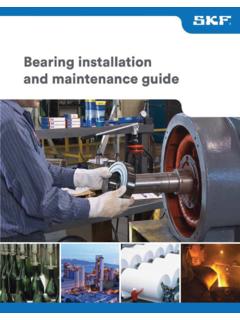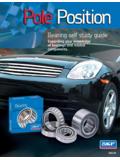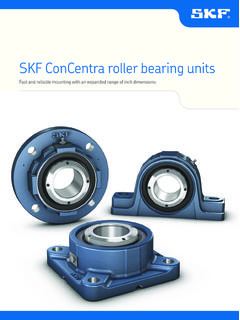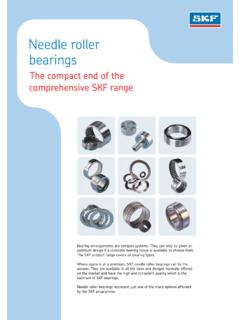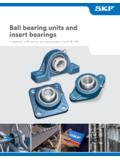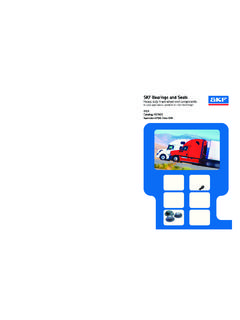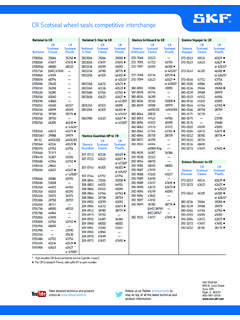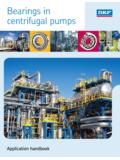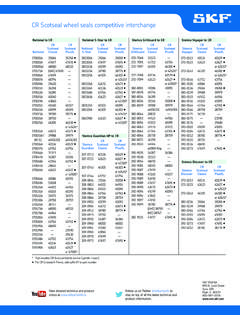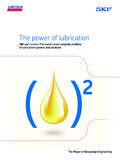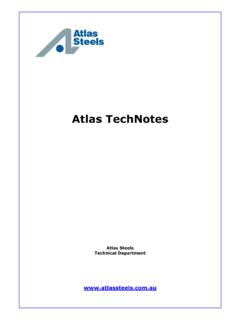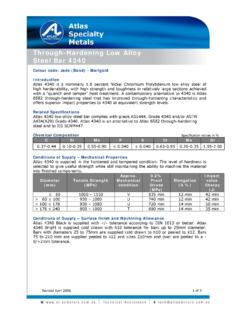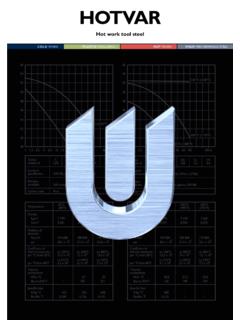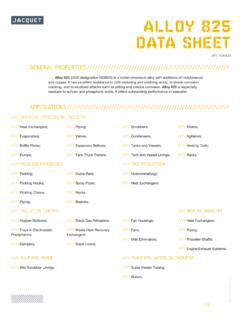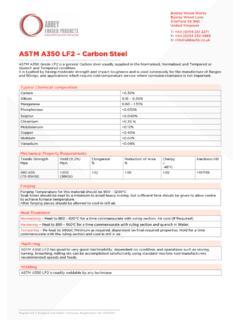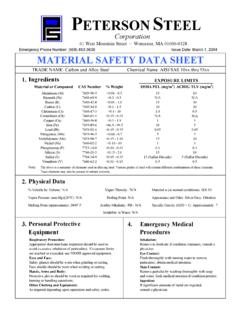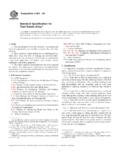Transcription of SKF composite plain bearings
1 SKF composit e plain bearingsCompact and maint ena nce-freeA Product information3 Compact and maintenance-free3 Characteristics3 The assortment6 Materials8 Machinability of composite materials9 Friction9 Chemical properties9 Electrical propertiesB Recommendations10 Selection of bearing size10 Basic load ratings11 Basic rating life11 Requisite bearing size13 Calculating basic rating life15 Application of bearings15 Material and surface finish of counterfaces15 Shaft and housing tolerances23 Design of associated components24 Seals25 Lubrication25 PTFE composite bearings25 POM composite bearings26 MountingC Product data27 bearing data general28 Product tables28 Metric composite straight bushings38 Inch composite straight bushings42 composite flanged bushings43 composite thrust washers44 composite stripsContentsD Additional information45 Related SKF products49 Application examples58 SKF the knowledge engineering company2 The SKF brand now stands for more than ever before, and means more to you as a valued SKF maintains its leadership as the hallmark of quality bearings throughout the world, new dimensions in technical advances, product support and services have evol ved SKF into a truly solutions-oriented supplier, creating greater value for solutions encompass ways to bring greater productivity to customers, not only with breakthrough application-specific products, but also through leading-edge design simulation tools and consultancy services, plant asset efficiency maintenance program mes, and the industry s most advanced supply management techniques.
2 The SKF brand still stands for the very best in rolling bearings , but it now stands for much the knowledge engineering companyCompact and maintenance-freeComposite plain bearings are primarily used for bearing arrangements where heavy loads have to be supported and where rotational or oscillating movements are relatively slow. Because of their good sliding properties and compact design, these plain bearings are par-ticularly suitable for bearing arrangements where maintenance-free operation is a prerequis ite there is a risk of lubricant starvation lubricants can not be used or are forbidden space is application examples for SKF compos-ite plain bearings can be found on pages 49 to important characteristics of SKF compos-ite plain bearings include maintenance-free no lubrication required (PTFE composite ) initial lubrication required (POM composite ) minimum wall thickness, minimum space requirements accommodation of heavy loads wide range of operating temperatures good sliding properties virtually no stick-slip high wear-resistance less sensitive to edge loading (POM composite )
3 No machining assortmentThe standard range of SKF composite plain bearings is very comprehensive and covers almost every standard size. The range is shown in the product overview in table 1 and com-prises straight bushings flanged bushings thrust washers 1 bearing type Series Bore diameter Lubrication Operating range temperature rangeStraight bushingsPTFE composite PCM .. E 3 300 mm None 200 to +250 C PCZ .. E 1/8 7 in None 200 to +250 CPOM composite PCM .. M 8 300 mm Initial lubrication 40 to +110 C only short periods +130 C PCZ .. M 3/8 4 in Initial lubrication 40 to +110 C only short periods +130 C Flanged bushings PTFE composite PCMF .. E 6 35 mm None 200 to +250 CThrust washers PTFE composite PCMW .. E 12 62 mm None 200 to +250 CPOM composite PCMW .. M 12 52 mm Initial lubrication 40 to +110 C only short periods +130 C Strips DimensionsPTFE composite PCMS .. E 500 200 mm None 200 to +250 C Height: 1 to 3,06 mm POM composite PCMS.
4 M 500 200 mm Initial lubrication 40 to +110 C Height: 1 to 3,06 mm only short periods +130 C 4 Continuation of table 1 Series Characteristics Product table on pagePCM .. E Metric straight bushings of triple-layer PTFE composite material, ( page 6). 28 Suitable for bearing arrangements that have to support radial loads only. For slow rotational or oscillating movements. Initial lubrication not required.. E Inch straight bushings of triple-layer PTFE composite material,( page 6). 38 Suitable for bearing arrangements that have to support radial loads only. For slow rotational or oscillating movements. Initial lubrication not required.. M Metric straight bushings of triple-layer POM composite material ( page 6). 28 Suitable for bearing arrangements that have to support radial loads only. For slow rotational or oscillating movements as well as linear movements. Initial lubrication required. Maintenance-free, except where there is a risk of misalignment, edge loading or moderate to severe.
5 M Inch straight bushings of triple-layer POM composite material ( page 6). 38 Suitable for bearing arrangements that have to support radial loads only. For slow rotational or oscillating movements as well as linear movements. Initial lubrication required. Maintenance-free, except where there is a risk of misalignment, edge loading or moderate to severe contamination. PCMF .. E Metric flanged bushings, made of triple-layer PTFE composite material, 42 ( page 6). Suitable for bearing arrangements that have to accommodate radial loads and axial loads in one direction. For slow rotational and oscillating movements. Maintenance-free. No lubrication .. E Metric thrust washers of triple-layer PTFE composite material, ( page 6). 43 Suitable for space-saving axial locating bearing arrangements. For slow rotational or oscillating movements. Initial lubrication not required.. M Metric thrust washers of triple-layer POM composite material ( page 6).
6 43 Suitable for space-saving axial locating bearing arrangements. For slow rotational or oscillating movements. Initial lubrication required. Maintenance-free except where there is a risk of edge loading or moderate to severe .. E Strips of triple-layer PTFE composite material, ( page 6). The strips 44 can be bent, pressed, cut etc. to fit the application. Suitable for space-saving arrangements of all types. Initial lubrication not required.. M Strips of triple-layer POM composite material ( page 6). 44 The strips can be bent, pressed, cut etc. to fit the application. Suitable for space-saving plain bearing arrangements of all types and where there is a risk of moderate contamination or edge loading. Initial lubrication required. 5 AMaterialsThere are two standard types of composite material for SKF plain bearings : PTFE com-posite and POM composite . Each is suit able for different compositePTFE composite bearings consist of a sheet steel backing on which a 0,2 to 0,4 mm thick porous layer of tin/bronze is sintered ( fig.)
7 1). By a rolling process, the pores of the sintered layer are filled with a mixture of PTFE (polytetrafluoroethylene) and molybde-num disulphide (designation suffix E). An additional 5 to 30 m thick running-in layer of the mixture is then applied to the sin-tered tin/bronze. This additional layer provides an optimum combination of the mechanical properties of the sintered tin/bronze and the good sliding and lubricating properties of the PTFE mixture. PTFE composite bearings have good dimensional stability and thermal compositeLike PTFE composite bearings , POM composite bearings also have a sheet steel backing that is covered with a 0,2 to 0,4 mm thick layer of sintered tin/bronze ( fig. 2). The principal characteristic of these bearings is their rela-tively thick (0,3 mm) layer of acetal resin (POM polyoxymethy l ene) that is firmly attached to the sintered tin/bronze layer. The covering layer has pockets to retain thickness of the covering layer makes these bearings less sensitive to misaligment and the edge loading associated with that composite materialFig.
8 1 PTFE (with additives)tin/bronzesheet steel backingtin layer*)POM composite materialFig. 2 POM (with additives)tin/bronzesheet steel backingtin layer*)* strips come without tin layer as standard* strips come without tin layer as standard6 Table 2 Summary of characteristics of SKF PTFE composite and POM composite materialsCharacteristics PTFE composite POM compositeComposition Material variant E Material variant M Steel backing with a layer of sintered Steel backing with a layer of sintered tin/bronze; pores filled and covered with tin/bronze; pores filled and covered with a layer (5 to 30 m) of PTFE with a layer (0,3 mm) of POM molybdenum disulphide additives Permissible specific static 250 250bearing load (N/mm2)Permissible specific dynamic 80 120bearing load (N/mm2)Maximum sliding velocity (m/s) 2 2,5 Operating temperature range ( C) 200 to +250 40 to +110 (+130 for short periods)Coefficient of friction 0,03 to 0,25 0,02 to 0,20 Stick-slip effect Negligible NegligibleWear layer thickness (mm) 0,2 0,3 Lubrication Not required Initial lubrication requiredAbility to support edge loads Fair Good( resulting from misalignment)Ability to carry alternating loads Good FairAbility to accommodate linear Fair GoodmovementsMachining of sliding surface Calibration Drilling, turning, (reaming)after mountingRecommended housing tolerance H7 H7for metric bushingsRecommended shaft tolerance f7 (for d 75 mm) h8 (h7)
9 For metric bushings h8 (for d > 75 mm) Required surface roughness Rz 3 Rz 6of mating surface ( m) Ra 0,4 Ra 0,8 Permissible surface machining Commercial shafts Commercial shafts of mating surface (ground or drawn) (drawn or fine turned)7 AMachinability of composite materialsWith the exception of the sliding layer, SKF composite bushings can be machined using conventional bushings are required to have a smaller width than the standard size, this can easily be achieved by turning. It is also possible to drill lubrication holes. However, any burrs must be removed, particularly from the sliding surface. Strips can be bent, pressed, cut, or drilled to fit the individual application. When cutting or drilling, it is advisable to work from the slid-ing surface side to avoid creating burrs in the sliding layer. Any metal surfaces that are exposed as a result of machining should be protected against the bore of PTFE composite bushingsPTFE composite bushings conform to ISO 3547:2006 and are ready for installation.
10 Any re-sizing of the bore, the sliding sur-face, will reduce the service life of the bush-ings and should only be done in exceptional cases. If re-sizing is necessary, the bore should be calibrated, using a mandrel/resizing tool ( fig. 3).Because various criteria, like material and wall thickness of the housing as well as the deviation of cylindrical form, have to be taken into consideration, SKF recommends using a calibrated mandrel to re-size the bore. After resizing, bushing bore expansion tests and application field tests should be undertaken prior to the release of a final product. When machining the calibrating mandrel, the diam-eter dk should be made in a first step about 60 to 80 m larger than the maximum value listed in the column Bore diameter of mounted bushing in table 1 on page values for the requisite interfer-ence of the calibrating mandrel as a function of the desired widening of the bushing bore for various bushing bore diameters can be obtained from diagram 1.
